|
|
[adapted from a 05-2001 Stereophile interview article]
I want Steve Hoffman’s job. I know, I know: “Get in line!” Just because Hoff man is the guy who does all the mastering for those fabulous DCC Compact Classics [DCC no longer exists--it was replaced by Audio Fidelity] releases, and just because he’s one of the few really highly regarded engineers of LP and CD reissues on the planet, Steve regularly gets to listen to the master tapes of all of our favorite music. It’s not fair!
I dropped by Hoffman’s hillside home in sunny Cal to sort this out, and to find out what it’s like to live the Audiophile’s of Reilly.
“I do love listening to master tapes, and yeah, for a while there it totally spoiled me from ever listening to an LP. For years I would hear an LP and I’d go, ‘I know what the master sounds like.’ When you’re threading up a master tape of Bob Dylan’s Highway 61 and you really crank it up, it’s like, ‘Wow, this is great. No one else can have this experience but me.’ I could charge tickets.
“But then when you really get right down to it, ‘Okay, now I have to work on this so that someone else can hear this when they buy a gold CD. How do I do that?’ Well, the first thing is, I have to turn it down. It’s not as much fun that way, but no one can master or mix any thing at a loud volume, because the next morning it will sound like crap. Always. Guaranteed. And I have to protect my ears. Our ears fatigue very easily, and once they do, I can’t work at all.”
“Come on. I’ll bet you listen to the tapes just once at volume, for kicks.”
“Oh, sure. I sit in the sweet spot and I’m like, Ahh, I like it like this.’ But then I hear all the little flaws in the tape and I go, ‘Well, I better do something to make this more the way I know they wanted it to sound.’ I sacrifice so that you all can hear what I hear in my work on any kind of stereo you want. That’s my little cross to bear.”
“I’m a little surprised that you not only have this fantasy job, but that you’re even able to do it from home.”
“I’m not one of those guys who love to hang around in a square room with no windows all day long. What used to happen is I’d come home from the studio and play what I did there, and I never liked it. It always sounded like crap here. Now they’ve set me up with a lot of gear at home, and I can roam around from room to room and listen. So when I go into the studio, it’s three hours there, I’m done. A month here, three hours there. That’s how I like it!”
“It’s probably better for the end result as well.”
“It is.”
“How did you get into the mastering-engineer line?”
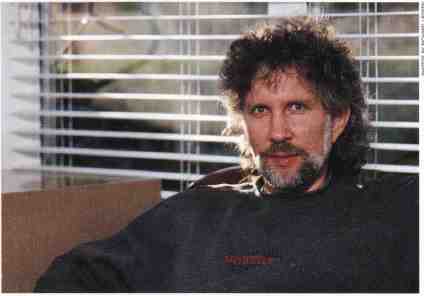
--- Steve Hoffman: He’s listened to more master tapes than you’ve had
hot dinners!
“With the record company that I used to work for in the ‘80s, my job was catalog development person. I had to come up with 20 LPs a month from the back catalog. Pick Bing Crosby, do the research, hear the records d do it all Out, write the liner notes, and hand it in. Next thing I’d know, the album would be out, and it was all wrong. So I’d make myself annoying and go up and say, ‘Look, you need to find the right tape. There’s no echo on a record from 1938.’ ‘Well, how do you know?’ ‘I just know. I have all these records. If they wanted echo on it, they would have put echo on it!’ Meanwhile, I was making enemies right and left, but that’s how I gravitated toward the mastering. Anyway, the very first one that I did made a lot of press...”
“Was it the Buddy Holly?”
“That’s right. And all of a sudden I realized that there were people out there just like me who wanted to hear something old sound good. I’d had engineering experience from working in broadcasting, so I knew the theories of compression and equalization and echo chambers and phasing and all that sort of stuff. But basically, if you find the right tape, you’re almost home. That, however, is not so easy to do. It’s a struggle. I don’t want to brag, but I don’t think anyone ever thought of that before me. It wasn’t the vault guys’ fault, but if you have a tape vault and ifs filled with 100,000 reels of tape and ifs your job every day to pull 1000 tapes, you’re going to go to the last one filed. So I had to start doing it myself.”
Hoffman offered to thread something up for us to listen to. While he fiddled in the room adjacent to his mastering/listening room, I waited in front of the immense Legacy Custom Focus speakers. I grinned when I heard Frank Sinatra speak: “. . . a little air between the horn fz and the down beat of the strings, s’il vous plait.” The orchestra materialized, and there followed a magically lush and swingin’ “My Kind of Town,” presented in full Close—your-eyes— and-you’re-there-Vision. I became only the third person since 1964 to hear that multi- track session tape. Now that was worth the price of an airline ticket! I even got to man the controls, and fade down the middle track to clearly hear just how incredibly great was the musicianship of those players.
Hoffman swears by tube gear. With the sound I heard from the VAC Renaissance Signature 70/70 amp and Renaissance Signature preamp, I could hear why. The tape itself was played on his stock 1960 vacuum-tubed Ampex 300-4.
“Most of the music in America pre 1966 was done on an Ampex. If you don’t play your tape back on one, then you have no idea what it really sound ed like when they heard it. I need to hear what it sounded like then, or else I wouldn’t have a clue as to how to do my work.”
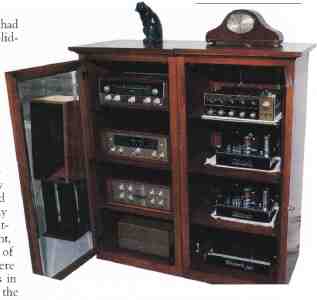
---Hoffman’s house could double as the Museum of Classic
Tube Gear.
Hoffman’s home is practically a museum of classic tube gear, from the Matchless guitar amp I coveted to the various cabinets loaded with classic McIntosh and Marantz amplifiers, all in cherry condition.
“I was a solid-state guy in the late ‘80s, when I first started with DCC. I had giant 500Wpc solid- state amps. I was working on this tape of Barney Kessel—a Contemporary Jazz record called ‘Some Like It Hot’. We didn’t end up releasing it, but I played it about 100 times trying to figure out how to make it sound good. Then I saw my second engineer’s little Mac 30s. I thought, ‘These are kind of neat-looking.’ There were two 6L6 GCs in each one for 35w the exact same tubes that are in all my Fender guitar amps. I tried just routing everything through them into the speakers. I punched it again, and all of a sudden Kessel was right there. It really floored me! Of course, the bass went to hell, and became slow and overloaded, but that magic midrange purity changed my life. From that point on I realized that you could play old stuff on older gear, and if you could ignore one or two annoying things, then you could have someone come to life in your living room. Of course, those old-fashioned amps like the little McIntoshes sound wonderful, but they’re slow. I have to figure out how to get that full and rich sound, but in a modern, fast way.”
“What do you specifically listen for in music? What qualities are most important to you?”
“If some part of the recording sounds lifelike. If I can hear something that resembles a breath of life, I’m happy. So, at a normal listening level like we’re talking right now, if I put Nat King Cole on here —‘When I Fall in Love’ —if your head turns over to him, like ‘Wow, he’s there,’ then I’ve done my job. If it sounds like a recording of Nat King Cole, then I haven’t done my job.”
“By ‘lifelike,’ does that include spatial qualities, like imaging, and getting the sense that he’s exactly in that spot in the room?”
“It’s not my first priority. Fortunately, those things are pretty much in stone on the tape if you enhance them correctly. A lot of the music that I listen to is so old that something like that would be impossible. Tonality is always number one for me. I’ll get on a Beatles kick, or it’ll be Beach Boys, Frank Sinatra, old 78s, oldies ye heard the music so many times on so many different stereos, when I hear it and it sounds good tonally, I’ll still go, ‘Wow, thank God I have a stereo that has that breath of life.’ If those audiophile qualities were my main thing, I would eliminate 70% of the music I listen to. I love those records and so do you. I wouldn’t call half the songs on Pet Sounds hi-fi . Would you?”
“Well...”
“No. But ifs one of those albums that you have to have buried with you in your coffin! Then again, on a really good setup, on some of those songs you hear soundstaging even though it’s in mono. It is exciting to me when you can really hear something into that murky area, because I guarantee you we weren’t able to hear that on our little Zenith phonographs back in those days. That’s for sure.”
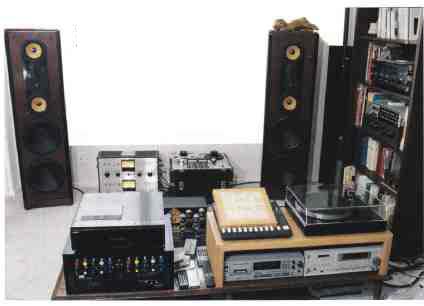
---This is the setup Hoffman couldn’t be without, featuring Legacy speakers
and VAC tube electronics.
“Most of us have got to figure out sooner or later that a reissue is rarely going to be as good as an original. Your stuff is an exception. Pet Sounds is a good example. I love the DCC, but I also really love my original. I listen to both, and they’re very different.”
“Yeah, absolutely. I can appreciate that the LPs have their own charming weirdnesses. What you like about the original is what they did to facilitate someone being able to enjoy that album then. I always think long and hard about my choices. I hate tampering with history. When I first started doing this job I went remix crazy, until I finally realized it’s not right if it’s not the original mix. ‘It’s the mix that they wanted! This is Brian Wilson’s child. He wanted it in mono.’ I don’t want to rewrite the past. I’m not God. So I try and stay away from that stuff, and with Pet Sounds, believe me, we had so much pressure on us. You have no idea.”
“Aside from the pressure you must have put on yourself for that project.”
“People would say, ‘Why is there so much bass on there?’ I didn’t add it. It’s on the tape that way. They couldn’t put it on the original record that way. The stylus would have jumped off the platter, and you would have run out of space. If you want to hear what the master tape sounds like, play our album. If you thread the tape up and put our record on, if you play them side by side and you switch back and forth, it matches. That’s how I did that particular project. If you want to hear exactly what they heard, you need to get yourself an old Altec speaker. Then that extra bass will make sense, and then that kind of missing upper midrange will also make sense because of the horn of the Altec. That’s how they did it, and I wanted to do for Brian what he was unable to do: ensure that his album would stay in mono the way he wanted it.”
“It’s funny, Steve. One of the things I look for on a reissue, right from the get-go, is if I hear that certain kind of tape hiss, because then I know it’s probably going to be good because nobody took that out.”
“Tape hiss is our friend. It’s like watching an old episode of Bonanza without a 1950s hairdo in the Old West. If you don’t see that, it’s not right. Now, when you hear your tape hiss and it doesn’t sound right, then you know somebody has been screwing around tonal-wise. This sounds so strange, but when you hear DCC tape hiss you can actually align your stereo to it. It’s like pink noise. It’s balanced from top to bottom because we don’t muck around with it.”
You have to do a little extra work to make sure that the CD comes back from the factory the way it came out.
“When you’re converting to digital, does that kind of tape hiss help bring up some of the quieter stuff, keep it from getting lost in the conversion, or. . . ?“
“Not the way I do it. It’s kind of a trade secret how I manage to keep the analog ambience intact even through the digital process. It’s a little trick I learned by accident one day. But once I made a whole CD of just tape hiss and noise and stuff. We had it manufactured at the factory and brought it back and compared the hiss very carefully to what I sent them, and it all matched, after I did one or two little cheating things. So I’ve done those little things the whole rime and it’s always come back correctly. You have to do a little extra work to make sure that it comes back from the factory the way it came out.”
We listened to “Let It Be .Me,” from the Hoffman-remastered The Everly Brothers’ Best (DCC GZS-1141), on his VAC/Legacy system via the impressive Sony SCD 777ES SACD player. Don and Phil voices seemed to clearly emanate from a large space centered between the speakers, while the players took more of a side seat. The effect was positively haunting, and beautiful.
In Steve's den, the system consisted of a Denon CD player with the more affordable VAC Avatar integrated amplifier and a pair of one of his favorite speakers, the 1967 British Tannoy GRE Windsors, designed by the legendary Guy R. Fountain. Here, the same track was presented much more ‘of a piece,’ with pleasing lateral spread of the vocals and instruments. I could have curled up in the sound and listened all day.
[2. Ray Charles, The Birth of Soul, Atlantic 82310-2, boxed set.]
Central to the newly arrived living-room system were the exquisite WAVAC MD— 300B direct-heated triode single-ended stereo power amp, designed by the late Nobu Shishido, with matching WAVAC PR-X1 line’ preamp designed by Mr. Y Ito. Even though the Kochel horns intended for these amps hadn’t shown up yet, those 10 little watts still sounded wonderful through the substitute pair of Legacy Victorias sitting on the floor. Everything connecting the system, from the power to the speakers, was from Pure Silver Connection (PSC), from Australia (imported by Jim Ricketts of tmh audio). The setup worked its SET magic on the vocals, giving them a seductively natural vibe. Steve and I were smitten. We followed the Er’erlys with Ray Charles’ “Lonely Avenue” and bobbed along with Brother Ray’s infectious phrasing. Fantastic.
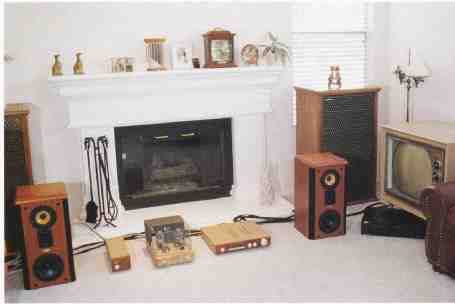
--- Single-ended WAVAC gear breathed life into music we played on the impromptu
living-room system.
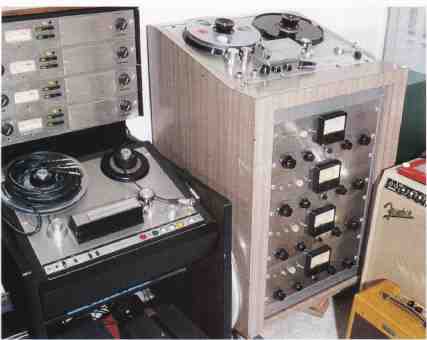
---Hoffman’s 1960 vacuum-tubed Ampex 300-4. If you don’t play the tapes
on one ot these, then you don’t know how they heard it back in the day.
“You talked a little bit about being true to the original recordings and the original visions of the artists. Does that imply that for all these old records, they were producing them the way they real ly wanted them to sound, more so than they do today?”
“Well, in the old days, they had A&R guys. These guys, they knew what they wanted. Frank Sinatra would do a song, and he’d just walk out. Frank knew Sonny Burke was going to release a good-sounding record, because he knew what good sound was. These guys all grew up playing in the ‘30s and the ‘40s. They knew what live music sounded like, horns and strings, and wanted to hear that on their records. I mean, you heard what those guys sounded like when you wiped the vocals off the mix. These guys could play. All you needed to do was go in there and put one mike here, one mike here, and one mike here, turn the machine on, and you’re done. You didn’t have to overdub. You didn’t have to do anything. It was a badge of honor that they were doing it live. Overdubbing was for sissies and rock ‘n roll guys.”
“It seems to me that in recording, the simpler approach is better. No?”
“Yes, simpler is always better. One good way to make it simpler is to be a big giant recording company and say, ‘You only have this much amount of time to do this album and then it has to go out.’ Like the Beatles’ Rubber Soul. If you read Mark Lewisohn’s book, they had under three weeks to get that whole album done for Christmas. They had no time for bickering, no rime for those agonizing second guesses. They did their best work like that.”
“So why can’t people make records that way today?”
“Although I love the Beatles more than anything, I think it’s all their fault. With Sgt. Pepper, they pioneered working without all of those time constraints, and everyone else followed suit. The problem is, they got on with it. Even when they did Abbey Road, they nailed that whole album in under a month. Just imagine that.”
“Yeah, even when they were fighting, when they were phoning it in, they still were able to produce that. Amazing. Steve, how much of the great sound of old records is due to the materials, or equipment, or techniques?”
“LP-wise, other than the fact that you’re cutting a stereo groove in an LP, it’s the same process that it was in 1900. Nothing has changed. You revolve the disc, you cut a hole, you suck up the thread, and it works. It worked in the acoustic era. It worked in 1925 when they invented microphones. It works now. It sounds great. It sounds much more dynamic than almost anything else out there. It sounds analog. It is analog. Those engineers from the 1950s, some of them really knew how to make a record sound good. You can pull out an old classical LP, and even though they were working under enormous obstacles to get 20 minutes on a side, either it’s a happy accident or they really knew what they were doing, but you really get a good breath of life. That’s why people are so fanatic about their old Mercury’s and RCA’s.
“Now, don’t get mc wrong. The minute these engineers could, in 1963, they abandoned this whole thing immediately for Dynagroove compression, multichannel, a million microphones, and they got transistorized everything because it was reliable. The problem is, it didn’t sound very good. But nobody noticed it at the time. So, like I say, a lot of old records were happy accidents because, yeah, they knew that they were making a record that would sound good on your RCA console, but you can’t tell me that they thought 40 years from now people were still going to be playing them. They wouldn’t have thought that in a million years. Some of the old stereo records sound just beyond wonderful. A lot of them sound better than the tapes, actually.”
“So, the master tape doesn’t always sound fantastic... ?“
“No. It doesn’t. How could that be? Well, any number of reasons. It’s got another five layers of vacuum-tube compression, or those old Westrex cutter heads had these wicked resonances around 10,000 cycles that flip phase on you. You remove all these things and you miss them. So the breath of life was added as they were cutting it. It’s just one of those things.”
“When you’ve got a tape, how do you know? How do you figure out how to add the breath of life?”
“I have it pretty much down to a science now. In a lot of tapes there’s no breath of life at all, and I want it on there. I’ll do anything to get it on there. You wouldn’t believe what I would do, or how I would do it. I ain’t going to tell you, either. [ But it gets on there one way or the other. Even on Metallica. It’s on there.”
“Some people say that all the great master tapes from the past are deteriorating. What’s your take?”
“Well, I’ve never found that to ever be the case. Not once. And I don’t understand why anyone else would even think that. I’ve heard tapes of all different ages going back to 1948, and the music and the tape hiss on them are always totally wideband-perfect. Once I walked into a large tape-storage facility, back in the early ‘80s, and I noticed in the waiting-room kitchen area a non—English-speaking worker, a vault- filer, was eating his lunch — a little pan pizza — on a box. That box was “Light My Fire” by the Doors the multi- track outtakes. The actual tape itself was thrown into a corner, unraveling, and he was eating on the box!
“Rick, I’ve worked with tapes that have been heated, and they’ve been frozen and they’ve been rained on. I’ve even worked with tapes that have actually been thrown up on. Honest. Dirt, fungus, tapes so used that the oxide had flaked off most of them, and I’ve always been able to get something off a tape that sounded better than a copy. I remember when CD first came in, and all the engineers were excited because they could transfer all the old tapes to this new medium. I recall one major label started doing that, and an engineer told me, ‘We took all our analog tapes and transferred them to digital. We’ve high-filtered them at 15,000 cycles and low-filtered them at 40 cycles, and now we’ve thrown them out. Isn’t it great?’”
“Ouch.
“Scary, isn’t it? The same thing happened when they went to LP. There’s a piece they used a lot in the Ken Burns Jazz documentary [Duke Ellington and his Famous Orchestra, “I Let a Song Go Out of My Heart,” 1938]. There’s all this added echo on it, and when I hear it, it’s funny, though it makes me want to cry. What happened is, they transferred all the 78s—badly and threw out the original metal mothers. So that’s all you have on a lot of these old songs now. That’s why I feel so strongly about the subject of saving the tapes.”
“Steve, what happens when you have to work on an album you don’t like?”
“It’s strange. It’s one of those weird transformations that can’t happen, but it really does. I have to learn to like some thing or I can’t master it. Another mastering engineer might have a pile of albums to do every single day, whether he wants to or not. He figures out what needs to be done, he does it, and he’s on to the next. I could never work that way. If it’s a famous album, I pull all the copies of it — the LP, the British LP, Japanese cutting—just to hear what everybody’s done. While I’m hearing it, I’m liking the songs more. It’d be like hearing a brand-new album with brand- new songs that you’ve never heard. The first time, it all sounds alike. The second time, there’s one song I like. By the end of the project, I know all the songs by heart and I’m liking it.”
“I’ve always had the impression that one of the reasons you get such great results is that you approach each project completely differently.”
“The only recipe I have is if it sounds good to me. See, I’m lucky that way. I don’t have a client that’s going to go, ‘This sounds like shit.’ I just have me, and I’m harder on me than any client would ever be. I pretty much know now that if I like the way it sounds, most everyone else is going to like it. You’re going to like it, Rick. Other than that, I wouldn’t be able to sleep at night. I feel the ghosts of the artists and the engineers and the producers are all hovering over me, watching me.”
“You come off like you do this job because you’re a guy like us, who loves the records.”
“It’s true. I’m lucky because I get paid to do this, and if I wasn’t getting paid, I would still be a record collector. People can talk endlessly on the Phonogram [3] list about the 1S cutting or the 7S cutting, and some of these guys have every single cutting. They spend hours doing it. I can absolutely relate to that. I have some Parlophone Beatles albums. Some were cut in the ‘60s, some in the late ‘60s, and some in the early ‘70s, and they all sound totally different from each other. You could go crazy doing that kind of stuff, but if you’re a real, true collector, you enjoy it.
“But it’s got to be about the music. Once you have to have a 15 cutting of everything, regardless, it’s just about being a collector. The music has to take precedence.”
[3.] For information on this vinyl-related discussion list, send a message to majordomographics.cornell.edu with the worth “info phonogram” in the message body.
.